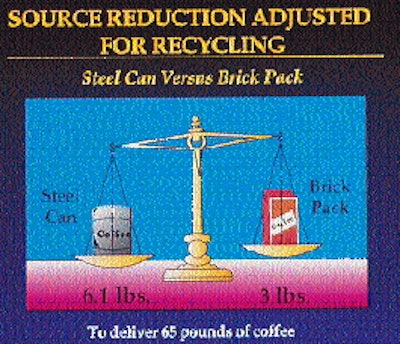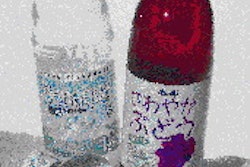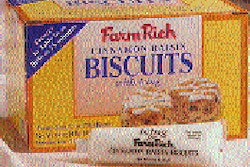After the drubbing steelmakers took in the beverage container business, they've been relatively quiet for several years. However, braced by profitability, improved productivity and plant utilization, the steel producers are giving packaging some strategic attention again. Although few are as publicly bullish as Nick Fellner (see p. 60), steel producers expect to recapture part of the beverage container business in the coming years. In the meantime, though, food packaging in steel cans will get a healthy push. A new group, the Steel Packaging Council, was formed by the members of the Tin Mill Producers group of the American Iron and Steel Institute. In May, the SPC reports positive results from a canned food awareness campaign it began last fall. "The purpose of the campaign is to dispel myths identified through our original study," says Robert Fatzinger, AISI director of product applications. ""We learned that consumers don't give canned food the credit it deserves when it comes to nutrition, convenience, variety and versatility." The five-year $12-million "What's in a can will surprise you" program involves advertising in women's magazines, publicity and events. SPC also hopes to develop cooperative marketing efforts with major canned food producers. Finally, with the help of the Canned Food Information Council and the Steel Recycling Institute, SPC has developed an educational program for teachers of high school students. Dispelling myths With the cooperation of CFIC, a part of the National Food Processors Assn., SPC is addressing consumer perceptions about food in cans. For example, only 44% of the public relate tin or steel as the material food cans are made of. Nearly 46% of the public say food cans are aluminum. Other myths are also being attacked: * Just 69% of the public realize that food cans are completely or somewhat recyclable. Meanwhile, the Steel Recycling Institute reports that the recycling level for steel cans reached an all-time high of 53% in 1994. In part, says SRI, that's due to a 220% increase in the recycling of empty aerosol cans last year, now available to consumers in 1꺜 communities nationwide. * Many people believe that salt is a preservative in canned foods, rather than a flavor enhancer. Others thought that different preservatives are used in canned foods. * While many consumers appreciate the shelf life of canned foods, few recognize that the nutritional levels of canned foods are often similar to those of fresh foods, according to NFPA research. Preliminary results of the promotion campaign, says Fatzinger, show improvements in readers' perceptions about canned food nutrition and label information. Overall, he says, 30% of Women's Day readers have a more positive feeling about canned foods since the campaign. A Florida winner The Steel Recycling Institute is also able to report that steel cans were the most recycled package in the state of Florida last year, according to that state's Department of Environmental Protection. The Florida rate, 64.4%, was more than 10 percentage points higher than the aluminum beverage can, the container that usually registers the highest rate in every state. The group is also taking a more aggressive stance about steel containers. Obviously irked by comparisons made by flexible packagers related to vacuum-packed coffee in steel cans vs flexible "bricks," SRI developed its own look at coffee packaging (see charts at left). Proponents of flexible packaging point to packaging source reduction for coffee packagers shifting from 1-lb steel cans to the foil laminated vacuum brick, from 20 lb to 3 lb. According to Bill Heenan, SRI president, those numbers would have been appropriate in '90 (lower chart). Today, thanks to lightweighting, steel cans would weigh 17 lb. However, since the most popular size for coffee is a 3-lb can, the total weight would drop to 13 lb. If you factor out the percentage of food cans that are recycled, the total becomes 6.1 lb of steel cans vs 3 lb of the vacuum brick for landfilling (upper chart). And that doesn't take into account the coffee cans that aren't discarded, but are used around the house and in workshops. At the AISI annual meeting in Chicago in May, the mood was very upbeat, but somewhat cautious. Steel producers had "a great year in '94, while '95 should be a very good year," according to Robert Grow, president of Geneva Steel. In a press conference during the meeting, Grow expects steel cans to make inroads in several markets including beverage cans. "Because of cost effectiveness," he says, "we're looking to recapture some old markets." One recurring theme of the annual meeting was that the steel industry has resized and refocused itself so it won't be as vulnerable to price pressure as it once was.























